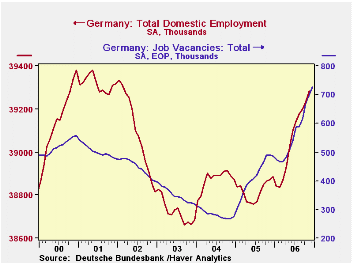 Global| Jan 03 2007
Global| Jan 03 2007German Labor Markets Maintain Gains; Unemployment at 4-Year Lows
Summary
The German labor markets look quite firm, according to labor force and unemployment data reported today for November and December. Total employment in November was 39.28 million, up 46,000 from October and 411,000 or 1.1% from [...]

The German labor markets look quite firm, according to labor force and unemployment data reported today for November and December.
Total employment in November was 39.28 million, up 46,000 from October and 411,000 or 1.1% from November 2005. It has risen every month since January (seasonally adjusted). Annual revisions were included in this release, altering some prior employment levels and unemployment rates. The general pattern is not affected, however.
The number of job vacancies remains supportive to further employment growth. At 728,000 in December (seasonally adjusted), these rose 27,000 in the month and are up substantially from 486,000 a year ago.
The unemployment situation has gained greater clarity in the last couple of months. When we last examined the German labor data two months ago, the ILO-based definition had shown some hesitation and remained above a recent low, even as the so-called "registered unemployment" measure was coming down. Now, the ILO rate has hit a new low, 7.7% of the labor force and the lowest since July 2002. This is off 1.2% from November 2005. The Germans' preferred measure, the "registered" unemployment rate, dipped below 10% to 9.8%, its first move into single digits since September 2002. This latter move is all the more significant for definitional changes in early 2005 that raised the level of reported unemployment. So the rate on this "new" basis is now well below many months calculated on the "old" basis and in fact is just 0.6% above its 2001 cycle low.
These labor market data correspond to results of recent business surveys in Germany, which we have described elsewhere as showing "growing optimism". They also mirror the improving employment readings in the purchasing manager surveys covering November; the manufacturing sector eased fractionally in its December results (reported yesterday), but remained in the high range of last spring. Taken together, it all seems to be showing improving conditions in Germany.
| Germany: Seas Adj, ex as noted | Dec 2006 | Nov 2006 | Oct 2006 | Year Ago | 2005 | 2004 | 2003 |
|---|---|---|---|---|---|---|---|
| LFS Employment (mil) | -- | 39.28 | 39.24 | 38.87 | 38.82 | 38.88 | 38.72 |
| Change (thous) | -- | +46 | +35 | +411 | -53 | +151 | -368 |
| Yr/Yr % Chg NSA | -- | +1.1 | -0.1 | +0.4 | -0.9 | ||
| Unemployment Rate (%, ILO Def.) | -- | 7.7 | 7.8 | 8.9 | 9.1 | 9.2 | 8.8 |
| Registered Unemployment Rate (%) | 9.8 | 10.1 | 10.3 | 11.3 | 10.8 | 11.7 | 10.6 |
| Job Vacancies (thous) | 728 | 701 | 671 | 486 | 413 | 284 | 352 |
Carol Stone, CBE
AuthorMore in Author Profile »Carol Stone, CBE came to Haver Analytics in 2003 following more than 35 years as a financial market economist at major Wall Street financial institutions, most especially Merrill Lynch and Nomura Securities. She has broad experience in analysis and forecasting of flow-of-funds accounts, the federal budget and Federal Reserve operations. At Nomura Securites, among other duties, she developed various indicator forecasting tools and edited a daily global publication produced in London and New York for readers in Tokyo. At Haver Analytics, Carol is a member of the Research Department, aiding database managers with research and documentation efforts, as well as posting commentary on select economic reports. In addition, she conducts Ways-of-the-World, a blog on economic issues for an Episcopal-Church-affiliated website, The Geranium Farm. During her career, Carol served as an officer of the Money Marketeers and the Downtown Economists Club. She has a PhD from NYU's Stern School of Business. She lives in Brooklyn, New York, and has a weekend home on Long Island.





